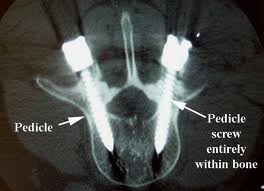 70% Screw Misplacement, NASS’s Fall Offensive, and more (Orthopedics This Week)
70% Screw Misplacement, NASS’s Fall Offensive, and more (Orthopedics This Week)
Screw Misplacement in 70% of Cases?!
Researchers from New York have just presented their paper, “Burying One’s Head in the Sand: Are We Underestimating the Significance of Pedicle Screw Misplacement?” Terry D. Amaral, M.D. is chief of pediatric orthopaedic surgery, at Montefiore Medical Center and assistant professor of surgery at Albert Einstein College of Medicine. He tells OTW, “We have ‘come a long way, baby’ as far as fixation, and there is now a push to do all of these surgeries as pedicle screw constructs. More and more we need to make sure that what we are doing is safe. The spinal cord is right next to where we are putting the screws in; we are also working near where the nerve roots exit…if you perforate that area the patient will experience weakness or even paralysis. Then in the front of the spine there are other things to be concerned about, like the aorta, the vena cava, the lungs, etc. Even world renowned surgeons are only attaining accuracy rates of 87-92%. If you have 100 patients and you’ve put screws in 12 vertebrae, that is 24 screws in each patient; so you’re looking at 2,400 pedicles…but that is making all patients into one group. If you have 10% inaccuracy, then that means that 2 out of 20 screws could be misplaced. Amazingly, we found that as many as 70% of patients may have a screw misplaced. Thankfully, most screws are just misplaced by a millimeter or two out the front or are slightly off medially, so they are not doing real damage. However, 5-10% of those misplaced screws are cause for concern.”
“To rectify this, we must have access to imaging devices during the procedure. We are beginning to look at intraoperative CT-scans and checking to see how accurate they are as compared to CT-scans done in a radiology suite. With intraoperative scans we can control how much radiation we are using; we are taking digital data and maximizing it with software. The software is able to interpret that digital information and give us better images. So the race is on to see which company can perfect the software. We’ve talked with Medtronic and they have significantly improved algorithms of translating that data so we can use a much lower dose of radiation. We are performing blinded, cadaveric studies, purposely misplacing the screws, and using an O-arm for imaging. Then we are putting the cadavers through a standard CT-scan and comparing the two. We also think that this software can be used for navigation where screw placement is done with the aid of a computer. In theory this might give us a military level accuracy. This is critical stuff…remember, if you’re off by ‘only’ a few millimeters then you’re in the aorta.”

 Tiger Buford – retained recruiter dissecting orthopedics
Tiger Buford – retained recruiter dissecting orthopedics